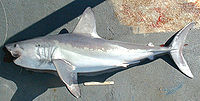
Photo from wikipedia
The hypothesis that Arctic tidal pools provide environmental conditions suitable for calcifiers during summer, thereby potentially providing refugia for calcifiers in an acidifying Arctic Ocean, was tested on the basis… Click to show full abstract
The hypothesis that Arctic tidal pools provide environmental conditions suitable for calcifiers during summer, thereby potentially providing refugia for calcifiers in an acidifying Arctic Ocean, was tested on the basis of measurements conducted during two midsummers (2014 and 2016) in tidal pools colonised by a community composed of macroalgae and calcifiers in Disko Bay, Greenland (69° N). The tidal pools exhibited steep diurnal variations in temperature from a minimum of about 6 °C during the night to a maximum of almost 18 °C in the afternoon, while the temperature of the surrounding shore water was much lower, typically in the range 3 to 8 °C. O2 concentrations in the tidal pools were elevated relative to those in the adjacent open waters, by up to 11 mg O2 L−1, and exhibited heavy super-saturation (up to > 240%) during daytime emersion, reflecting intense and sustained photosynthetic rates of the tidal macroalgae. The intense photosynthetic activity of the seaweeds resulted in the drawdown of pCO2 concentrations in the pools during the day to levels down to average (±SE) values of 66 ± 18 ppm, and a minimum recorded value of 14.7 ppm, corresponding to pH levels as high as 8.69 ± 0.08, as compared to CO2 levels of 256 ± 4 and pH levels of 8.14 ± 0.01 in the water flooding the pools during high tide. The corresponding Ωarag reached 5.04 ± 0.49 in the pools as compared to 1.55 ± 0.02 in the coastal waters flooding the pools. Net calcification averaged 9.6 ± 5.6 μmol C kg−1 h−1 and was strongly and positively correlated with calculated net ecosystem production rates, which averaged 27.5 ± 8.6 μmol C kg−1 h−1. Arctic tidal pools promote intense metabolism, creating conditions suitable for calcification during the Arctic summer, and can, therefore, provide refugia from ocean acidification to vulnerable calcifiers as extended periods of continuous light during summer are conducive to suitable conditions twice a day. Meroplankton larvae are exposed to ocean acidification until they settle in vegetated tidal pools, where they benefit from the protection offered by the “macroalgae-carbonate saturation state” interaction favouring calcification rates.
Journal Title: Estuaries and Coasts
Year Published: 2018
Link to full text (if available)
Share on Social Media: Sign Up to like & get
recommendations!